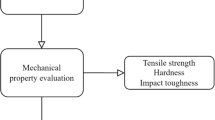The authors studied the specifics of the kinetics of austenite decomposition in the near-weld region of the heat-affected zone, as well as the weld metal under the welding process conditions used in the construction of main gas pipelines made of promising K80 strength grade steels. An approach to selecting rational cooling rates during welding is presented.






Similar content being viewed by others
References
A. V. Konovalov, A. S. Kurkin, E. L. Makarov, V. M. Nerovnyi, and B. F. Yakushin, Theory of Welding Processes [in Russian], ed. by V. M. Nerovnyi, MGTU im. N. E. Bauman, Moscow (2007).
E. L. Makarov, Theory of Weldability of Steels and Alloys [in Russian], MGTU im. N. E. Bauman, Moscow (2018).
V. I. Stolyarov et al., “Weldability of high-strength steels for large-diameter gas pipelines,” Probl. Chern. Metall. and Materialoved., No. 3, 39–47 (2008).
D. A. Ringinen et al., “Study of weldability of X100 strength grade steel,” Metallurg, No. 12, 68–74 (2013).
I. I. Frantov, I. L. Permyakov, and A. N. Bortsov, “Kinetics of phase transformations of austenite in the near-weld and heat-affected zones during welding of microalloyed pipe steels,” Probl. Chern. Metall. and Materialoved., No. 3, 38–45 (2011).
L. A. Efimenko, O. Yu. Elagina, E. M. Vyshemirsky, O. E. Kapustin, A. V. Muradov, and A. K. Prygaev, Conventional and Promising Steels for the Construction of Main Gas and Oil Pipelines [in Russian], Logos, Moscow (2011).
L. A. Efimenko, A. A. Ramus, and A. O. Merkulova, “Specifics of austenite decomposition in the heat-affected zone during welding of high-strength steels,” Fizika Metallov i Metallovedeniye, 116, No. 5, 520 (2015).
STO Gazprom 2-4.1-713-2013, Technical Requirements for Pipes and Fittings [in Russian], Moscow (2014).
L. I. Efron, Metal Science in Large Metallurgy, Pipe Steels [in Russian], Metallurgizdat, Moscow (2012).
M. Yu. Matrosov, I. V. Lyasotskii, A. A. Kichkina, D. L. Dyakonov, and A. A. Efimov, “Specifics and classification of structures of low-carbon low-alloy high-strength pipe steels,” Stal’, No. 1, 65–74 (2012).
I. A. Yakubtsov and J. D. Boyd, “Bainite transformation during continuous cooling of low carbon microalloyed steel,” Materials Science and Technology, 17, No. 3, 296–301 (2001).
Yu. D. Morozov, M. Yu. Matrosov, S. Yu. Nastich, and A. B. Arabey, “New generation high-strength pipe steels with ferrite-bainite structure,” Metallurg, No. 8, 39–42 (2008).
M. A. Smirnov, I. Yu. Pyshmintsev, and A. N. Boryakova, “On the classification of microstructures of low-carbon pipe steels," Metallurg, No. 7, 45–51 (2010).
D. Bai, L. Collins, and F. Hamad, “Microstructure and mechanical properties of high strength linepipe steels,” in: Materials Science and Metallurgy and Technology (MS&T), Steel Product Applications: Thermomechanical Processing, Detroit (2007), pp. 355–367.
A.Yu. Ivanov, R.V. Sulyagin, and G.D. Motovilina, “Structure and properties of the heat-affected zone of X80 strength grade steel pipes welded with different heat input,” Metallurg, No. 6, 58–64 (2011).
L.A. Efimenko and A.A. Ramus, “Effect of structure morphology on the brittle fracture resistance of welded joints of high-strength pipe steels,” MiTOM, No. 9 (723), 41–45 (2015).
STO Gazprom 2-2.2-136-2007, Instruction on Welding Technologies for Construction and Repair of Field and Main Gas Pipelines [in Russian], Part I, Moscow (2007).
Author information
Authors and Affiliations
Corresponding author
Additional information
Translated from Metallurg, Vol. 67, No. 9, pp. 78–82, September, 2023. Russian DOI https://doi.org/10.52351/00260827_2023_09_78.
Rights and permissions
Springer Nature or its licensor (e.g. a society or other partner) holds exclusive rights to this article under a publishing agreement with the author(s) or other rightsholder(s); author self-archiving of the accepted manuscript version of this article is solely governed by the terms of such publishing agreement and applicable law.
About this article
Cite this article
Efimenko, L.A., Ramus, A.A., Utkin, I.Y. et al. The Role of the Weld Metal Structure Formation in Selecting Rational Cooling Rates When Welding K80 Strength Grade Steel. Metallurgist 67, 1344–1350 (2024). https://doi.org/10.1007/s11015-024-01626-4
Received:
Revised:
Accepted:
Published:
Issue Date:
DOI: https://doi.org/10.1007/s11015-024-01626-4




